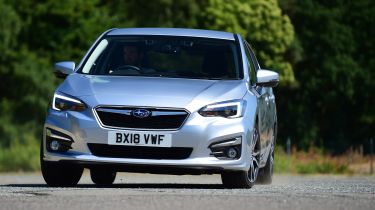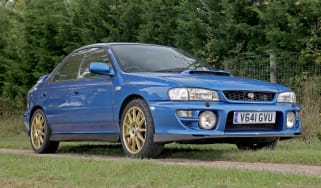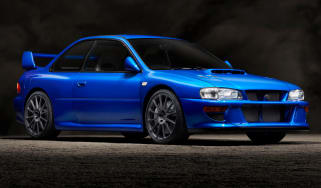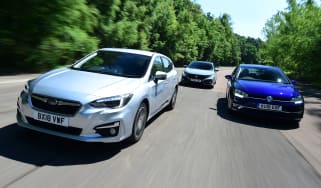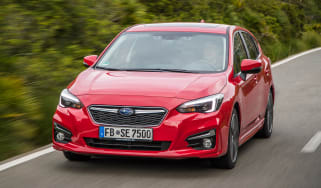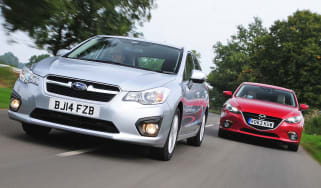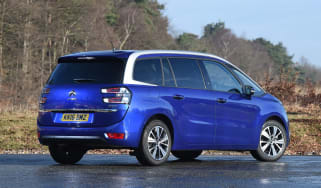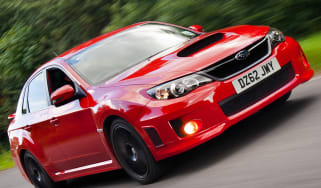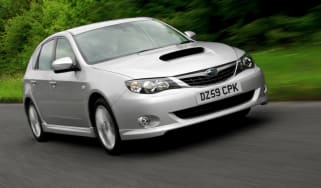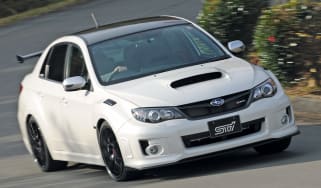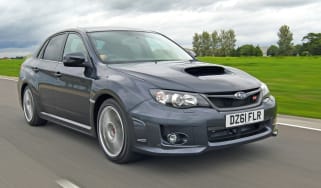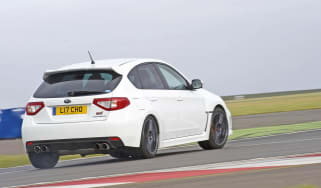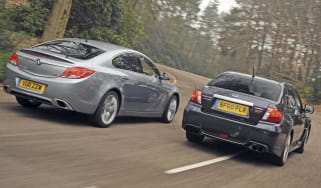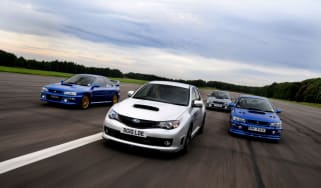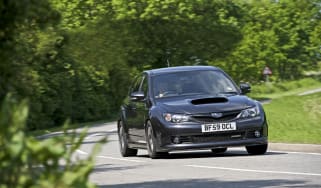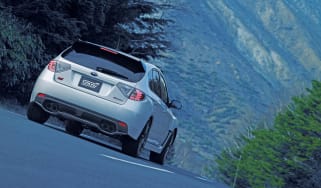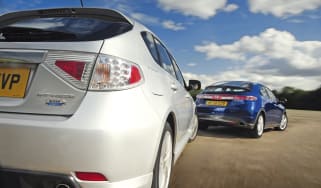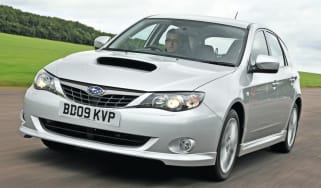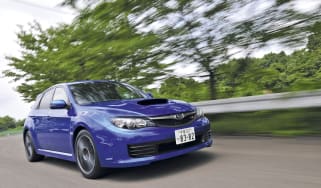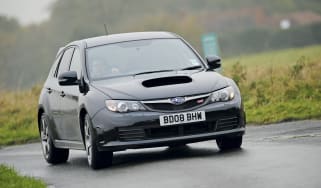Subaru Impreza review
More spacious and better to drive, the fifth generation Subaru Impreza is a highly likeable four-wheel-drive hatchback

The fifth generation Subaru Impreza represents a huge improvement over the last car, as it offers more space inside, a better cabin and surprisingly good road manners. It also looks a whole lot better, with sharp styling replacing a rather frumpy design.
Your options are refreshingly limited, with just one trim level offered in the UK, a single CVT automatic transmission and a choice of two petrol engines. The 1.6-litre version is too lethargic to recommend, so our choice would be the more powerful and hardly any less efficient 2.0-litre, which also has the benefit of steering-wheel-mounted paddles.
The excellent EyeSight pre-collision driver assist system is fitted as standard, which contributes to a maximum five-star safety rating. It also scored the highest ever rating in Japanese crash testing.
It won’t be a volume seller in the UK, but Subaru loyalists are sure to find much to like about the fifth generation Impreza.
The Subaru Impreza for sale today is a very different car to the one of old. While the rally-bred WRX and STi models were popular for their useable performance, there are no such potent machines now offered as part of the Impreza range. Instead you get a sensible five-door four-wheel-drive hatchback that cater for a more sedate and conventional audience.
Used - available now

2023 Hyundai
i20
20,795 milesManualPetrol1.0L
Cash £12,999
2023 Hyundai
i20
9,452 milesAutomaticPetrol1.0L
Cash £14,499
2018 Audi
Q2
48,179 milesAutomaticPetrol1.4L
Cash £13,697
2019 Toyota
Yaris Hybrid
26,994 milesAutomaticPetrol1.5L
Cash £11,700Not that this is a hugely conventional car. It’s one of only a few five-door family hatchbacks to offer four-wheel drive – the other two are the more expensive Audi A3 Sportback quattro and BMW 1 Series xDrive – and with just petrol engines and a single CVT transmission on offer, the Impreza is going to appeal to a rather niche group of buyers.
If you were put off by the Impreza’s lethargic and wheezy predecessor, you might want to take another look at this new model, because Subaru has given it a thoroughly convincing overhaul
It’s bigger, which translates to a more spacious cabin, while a more rigid body and a lowered ride height ensure that it’s actually pretty decent to drive. There are two petrol engines available – a 1.6-litre and a 2.0-litre – with steering wheel-mounted paddles on the larger engine the only specification difference between the two.
There’s only one trim level available in the UK, with the SE model loaded with standard kit. The package includes 17-inch alloy wheels, heated front seats, dual-zone climate control, an eight-inch touchscreen, Apple CarPlay and Android Auto. Curiously, sat-nav isn’t available, but then those two smartphone systems mean that’s no great loss.
It’s hard to make a case for the 1.6-litre Impreza, which starts from around £24,000. It could be a good car, were it not for the fact the CVT Lineatronic transmission robs it of what little power is available. With a price tag of around £25,000, the 2.0-litre version isn’t that much more expensive and is unlikely to be significantly less economical. You also get the bonus of the paddle shifters, which enhance the overall driving experience.
From a family hatchback perspective, the Impreza isn’t a cheap car, but the additional outlay is offset by a comprehensive warranty, excellent safety credentials and Subaru’s good reputation for reliability. The Impreza is an interesting alternative to the glut of compact SUVs on sale and could come into its own during winter months or in hazardous driving conditions.
Engines, performance and drive
The previous Impreza wasn’t exactly a firecracker to drive, and while this fifth generation version doesn’t live up to the sporting WRX and STi models of old, it represents a marked improvement over the last version.
There are just two four-cylinder boxer petrol engines to choose from – a 112bhp 1.6-litre and a 154bhp 2.0-litre – both of which feature come with a CVT automatic transmission, which Subaru calls Lineartronic. There’s no manual gearbox option, although the 2.0-litre version is fitted with steering wheel-mounted paddles to boost driver engagement a little.
It’s partly because of the paddles that we’d recommend the 2.0-litre over the 1.6-litre. Neither of the engines are particularly powerful – and the CVT does its best to blunt the performance – but the paddles give you a greater feeling of control and come into their own when the transmission holds on to high revs for too long.
Subaru has listened to the criticisms of the old Impreza in terms of dynamics, and has built a car that is 100 per cent more rigid than before, while dropping the ride height by 5mm. As a result, the Impreza corners with very little roll, while the well weighted steering inspires you to press on through the corners.
Factor in a positive feel through the brake pedal and bags of grip from the four-wheel-drive system, and you have the makings of a confidence-inspiring hatchback. Only a harsh ride over the worst surfaces and the weight of the AWD system stop the Impreza from rivalling the likes of the Ford Focus and Peugeot 308 for driving dynamics.
Engines, 0-60 acceleration and top speed
The key to getting the best out of the Subaru Impreza is to approach the CVT transmission with a light foot. Anything resembling a hard press on the accelerator pedal will result in lots of noise and very little action.
It’s far better to let the CVT do the work, although this is easier said than done in the 1.6-litre version, which feels very lethargic, especially when climbing hills. The 12.4 seconds it takes to sprint from 0-62mph only tells half the story – this car can feel painfully slow. The top speed is 112mph.
Things are slightly better in the 2.0-litre version, with the 0-62mph time dropping to 9.8 seconds and the top speed increasing to 127mph. The paddles make a huge difference, helping to deliver the impression that the Impreza has a dual-clutch transmission.
MPG, CO2 and Running Costs
When powered by the 1.6-litre boxer petrol engine, Subaru claims that the Impreza will return 35.9mpg on a combined cycle. This is lower than the original 44.1mpg when tested under the old NEDC method, but the WLTP should be more reflective of what you can expect to achieve in the real world.
Confusingly, the 2.0-litre hasn’t been tested using the WLTP method yet, so the figure of 42.8mpg might be a tad optimistic. Using the 1.6 as a guide, expect economy of around 33mpg to be achiveable.
With permanent four-wheel drive, a CVT transmission and a choice of two petrol engines, the Impreza is hardly geared up to deliver good fuel economy. In fact, if you’re after practicality and efficiency, even the latest compact SUVs might be more suited to your needs.
You also need to factor in the cost of parts and servicing, which tend to be higher than the more mainstream manufacturers, although this should be offset by Subaru’s reputation for reliability and dependability.
With CO2 emissions of 151g/km (WLTP) and 152g/km (NEDC) for the 1.6 and 2.0 models respectively, you’ll pay £140 to tax the Impreza from year two, with a £515 figure for the first year.
Insurance groups
The 1.6-litre Impreza slots into a reasonably low group 12 insurance rating, but with a group 18 rating, the 2.0-litre will cost more to insure. However, all but the entry-level versions of the Audi A3 Sportback with quattro all-wheel drive will be more expensive to insure, while all BMW 1 Series xDrive models slot into groups 23 and 24.
Depreciation
The Impreza is a niche purchase, so finding a second hand example tends to be tougher than it would be with a more mainstream model. The car is also hampered by relatively inefficient petrol engines, the absence of a manual gearbox and a high price tag when new. All of which leads to a steeper depreciation curve, especially during the early years, while a 34 per cent rating for three years/30,000 miles is similar to the Peugeot 308.
To get an accurate valuation on a specific model check out our free car valuation tool...
Interior, design and technology
Although this fifth-generation Impreza looks more stylish than its drab and dowdy predecessor, the styling is a tad generic, falling somewhere between a Vauxhall Astra, Peugeot 308 and Ford Focus.
It’s an inoffensive look, but thanks to its niche position within the five-door hatchback segment, some exclusivity is guaranteed. Colour options are limited, with only six hues to choose from, although automatic LED headlights, 17-inch alloy wheels and a roof spoiler are standard across the range.
On the inside, the Impreza is leagues ahead of Subaru models of old, with a higher quality finish and a nicer range of materials than before. European rivals remain just ahead, but there’s an overriding feeling that the cabin is built to last and designed to cope with the demands of a four-wheel-drive vehicle.
Everything feels reassuringly solid, while the conventional layout is a breath of fresh air in an industry where form can often overrule function. Thanks to the six-way adjustable driver’s seat, finding a comfortable driving position isn’t a problem, while heated seats are fitted as standard.
Indeed, Subaru has adopted a ‘kitchen sink’ approach to equipment, fitting the Impreza with just about everything as standard. This includes dual-zone climate control, steering wheel controls, a reversing camera and cruise control, with the only difference between the 1.6 and 2.0 models being the addition of paddle-shifters on the larger engined model.
Sat-nav, stereo and infotainment
It’s a shame, then, that Subaru has chosen to omit sat-nav from the list of equipment. The company argues that many drivers would prefer to use Apple CarPlay or Android Auto for navigation. And while this might be true, it would have been better to give customers a choice.
The eight-inch touchscreen infotainment system looks the part, but is too laggy and unresponsive to match the best units on the market. At least the Impreza offers DAB radio, Bluetooth and two USB ports.
There’s also an additional high-mounted display that shows additional driving information, climate control settings, the outside temperature and a clock.
Practicality, comfort and boot space
The Impreza is the most conventional car Subaru builds, but remains perfectly practical among the SUVs and rugged estate cars of the range. In fact, as a five-door hatchback, it’s no less practical than the platform sharing XV, but the Levorg estate offers a significantly larger boot.
Dimensions and size
This newer version of the Impreza is larger than the Mk4 and this translates into a more spacious interior. The cabin is 29mm wider at the front and 34mm wider at the rear, so there’s enough room to seat five adults.
At 4,415mm in length, the Impreza is longer than the Volkswagen Golf (4,258mm) and shorter than the Skoda Octavia (4,659mm). The width is 1,740mm (excluding door mirrors) and the height is 1,465mm with roof rails.
Leg room, head room & passenger space
The interior feels more spacious than ever, helped in no small part by the additional width. This latest version also offers 26mm more rear seat legroom than before.
Up front, the driver will find it easy to find a good driving position, while there’s no shortage of space for the front seat passenger. Thanks to a recess carved into the roof lining, rear seat occupants will find plenty of headroom, while leg- and knee-room are perfectly adequate for a car of this size.
Adults can sit three abreast in the rear, although the transmission tunnel will make long journeys a little uncomfortable for middle seat passengers as there’s nowhere to place your feet.
Boot space
Maximum luggage capacity is up 5 litres over the previous model, but the Impreza can only muster 385 litres of boot space. This is the same as you’ll find in the XV, but the Levorg offers a relatively cavernous 522 litres of space.
For comparison, the five-door Volkswagen Golf has a 380-litre boot, while the Honda Civic offers 487 litres. However, few cars rival the Skoda Octavia hatchback, in which you’ll find a cavernous 590-litre boot.
The Impreza’s 60/40 split-folding rear seats lie flat when folded down and are operated via levers next to the headrests. Thanks to the increased width of the car, the boot features a 100mm wider opening than before and the depth of the boot is longer by 41mm.
Reliability and Safety
Euro NCAP awarded the Impreza a five-star safety rating when the car was crash tested in 2017, including an impressive 94 per cent for adult occupant safety. Other scores included 89 per cent for child occupant safety, 82 per cent for pedestrian safety, and 68 per cent for safety assist technologies.
Subaru is justifiably proud of its EyeSight technology, which is standard on the Impreza. The technology dates back to 2008 when it was launched as the world’s first safety device using stereo cameras. A decade on, EyeSight has been further developed and, in demonstrations, has proved to be very effective.
EyeSight comprises six pre-collision driver assist systems, namely: adaptive cruise control, lane departure warning, lane keep assist, pre-collision braking, pre-collision throttle management and steering assist, and lead vehicle start alert.
Blind spot monitoring, high beam assist, multiple airbags, rear cross traffic alert and a reversing camera are fitted as standard, plus you benefit from the security of having permanent four-wheel drive.
Neither Subaru nor the Impreza featured in our 2018 Driver Power customer satisfaction survey, but the company has developed a reputation for reliability and good customer service. Many Subaru owners hold on to their cars for long periods, staying loyal to their local dealer. You can buy an Impreza with confidence.
Warranty
The Subaru Impreza is covered by an excellent five-year/100,000-mile warranty, which rivals the likes of Hyundai and Toyota, and is only two years behind market leader Kia. The bodywork is covered by a 12-year anti-corrosion warranty, while the paintwork is covered for three years.
Servicing
A problem faced by Subaru owners is a relative lack of dealers – you may have to travel a long distance for servicing and maintenance. Furthermore, when you get there, parts and labour can be more expensive than at a mainstream dealer.
The Impreza requires a service every year or 12,000 miles, which is more frequent than some of its volume rivals. Also, Subaru doesn’t offer any pre-paid service plans.
